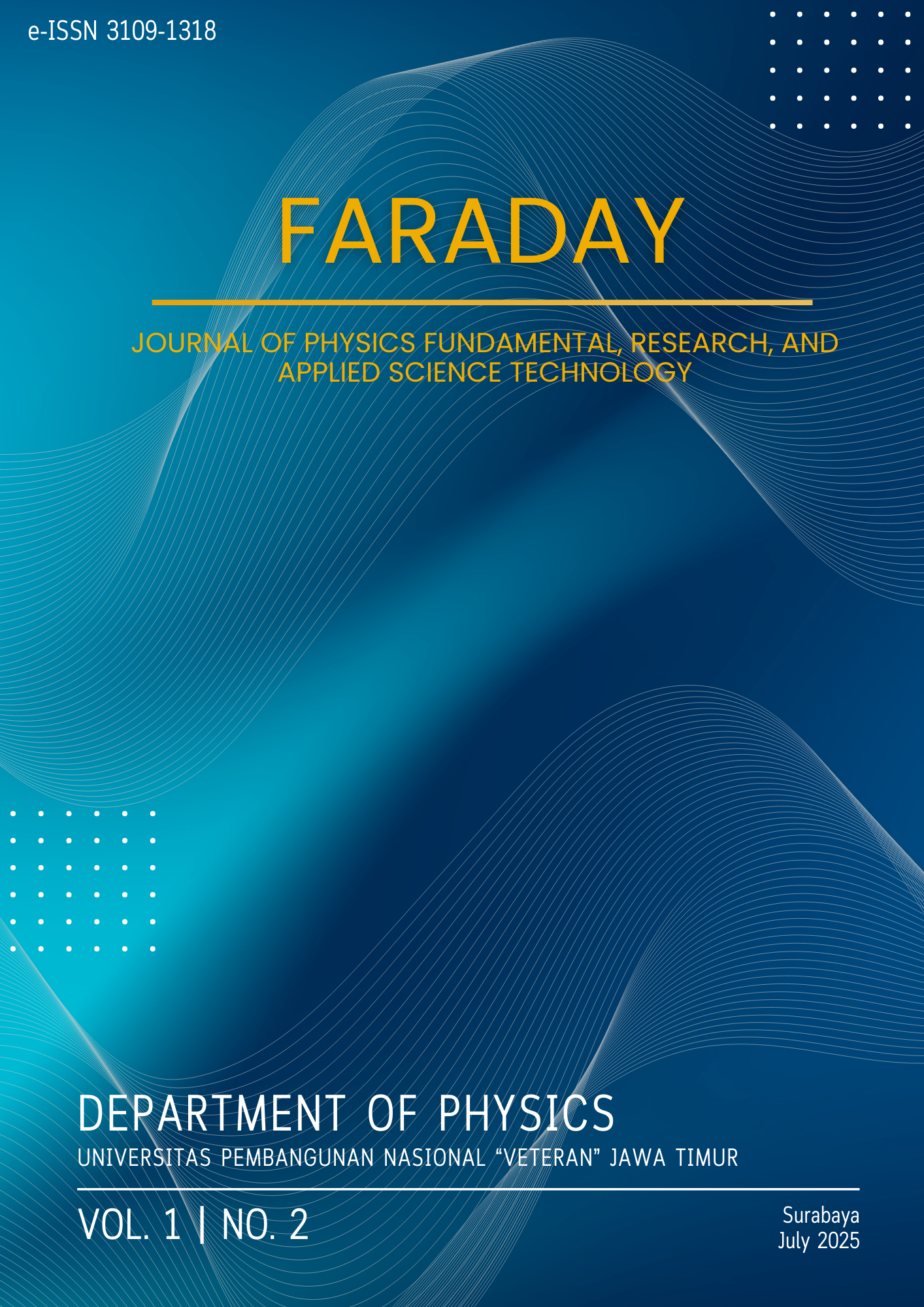Comparative Analysis of CCS811 Sensor Usage in Wearable Studies for Cigarette Smoke Detection: Literature Review
DOI:
https://doi.org/10.33005/faraday.v1i2.16Keywords:
CCS811 sensor, wearable, cigarette smoke, Air quality, Room sizeAbstract
The CCS811 sensor is a metal oxide semiconductor (MOX)-based gas sensor that is widely used in wearable systems to monitor air quality personally, especially in detecting volatile organic compounds (VOCs) contained in cigarette smoke. This study aims to conduct a systematic review of various studies that implement the CCS811 sensor in wearable devices for cigarette smoke detection, focusing on aspects of accuracy, sensitivity, detection time, and the effect of room size. The method used is a systematic literature review of 19 scientific articles published in the last ten years. The results of the review show that the CCS811 has several advantages, such as low power consumption, compact sensor size, real-time VOC detection capability, and easy integration with the Internet of Things (IoT) system. Quantitatively, this sensor is able to detect TVOC concentrations in the range of 20–1158 ppb, with a response time of less than 20 seconds in a small space. However, limitations are still found in terms of selectivity to certain types of compounds and the lack of studies evaluating the effect of room characteristics on detection performance. This study recommends further testing in various real-world conditions as well as the application of machine learning algorithms to improve the accuracy and adaptability of the CCS811-based wearable system in effectively detecting cigarette smoke.
Downloads
References
Al-Absi, M.A., Al-Absi, A.A., Sain, M., & Lee, H. (2021). Moving ad hoc networks—a comparative study. Sustainability (Switzerland) , 13 (11). https://doi.org/10.3390/su13116187
Alhadawiah, S., Budianto, A., Wirawan, R., Ketut Anggriani, N., & Info, A. (2025). GeoScienceEd 6(1) (2025) Making Exhaled Air Profiles of Smokers and Non-Smokers Based on CCS-811 Sensor and Volatile Organic Compounds . https://doi.org/10.29303/geoscienceed.v6i1.506
Al-Okby, M. F. R., Junginger, S., Roddelkopf, T., Huang, J., & Thurow, K. (2024). Ambient Monitoring Portable Sensor Node for Robot-Based Applications. Sensors , 24 (4). https://doi.org/10.3390/s24041295
E. Sazonov, MHI and ST (2018). Guest editorial . https://mc.manuscriptcentral.com/tmbmc
Erdem, HE, Yildiz, HU, & Gungor, VC (2019). On the Lifetime of Compressive Sensing Based Energy Harvesting in Underwater Sensor Networks. IEEE Sensors Journal , 19 (12), 4680–4687. https://doi.org/10.1109/JSEN.2019.2900427
Faiazuddin, S., Lakshmaiah, MV, Alam, KT, & Ravikiran, M. (2020). IoT based Indoor Air Quality Monitoring system using Raspberry Pi4. Proceedings of the 4th International Conference on Electronics, Communication and Aerospace Technology, ICECA 2020 , 714–719. https://doi.org/10.1109/ICECA49313.2020.9297442
Imtiaz, M.H., Ramos-Garcia, R.I., Wattal, S., Tiffany, S., & Sazonov, E. (2019). Wearable sensors for monitoring of cigarette smoking in free-living: A systematic review. In Censorship (Switzerland) (Vol. 19, Issue 21). MDPI AG. https://doi.org/10.3390/s19214678
Kuncoro, CBD, Asyikin, MBZ, & Amaris, A. (2022). Smart-Autonomous Wireless Volatile Organic Compounds Sensor Node for Indoor Air Quality Monitoring Application. International Journal of Environmental Research and Public Health , 19 (4). https://doi.org/10.3390/ijerph19042439
Rudavskyi, I., Klym, H., Kostiv, Y., Karbovnyk, I., Zhydenko, I., Popov, A.I., & Konuhova, M. (2024). Utilizing an Arduino Uno-Based System with Integrated Sensor Data Fusion and Filtration Techniques for Enhanced Air Quality Monitoring in Residential Spaces. Applied Sciences (Switzerland) , 14 (19). https://doi.org/10.3390/app14199012
Salamone, F., Masullo, M., & Sibilio, S. (2021a). Wearable devices for environmental monitoring in the built environment: A systematic review. In Censorship (Vol. 21, Issue 14). MDPI AG. https://doi.org/10.3390/s21144727
Salamone, F., Masullo, M., & Sibilio, S. (2021b). Wearable devices for environmental monitoring in the built environment: A systematic review. In Censorship (Vol. 21, Issue 14). MDPI AG. https://doi.org/10.3390/s21144727
Seneviratne, S., Hu, Y., Nguyen, T., Lan, G., Khalifa, S., Thilakarathna, K., Hassan, M., & Seneviratne, A. (2017). A Survey of Wearable Devices and Challenges. In IEEE Communications Surveys and Tutorials (Vol. 19, Issue 4, pp. 2573–2620). Institute of Electrical and Electronics Engineers Inc. https://doi.org/10.1109/COMST.2017.2731979
Senyurek, V., Imtiaz, M., Belsare, P., Tiffany, S., & Sazonov, E. (2019). Cigarette smoking detection with an inertial sensor and a smart lighter. Censors (Switzerland) , 19 (3). https://doi.org/10.3390/s19030570
Tai, LC, Ahn, CH, Nyein, HYY, Ji, W., Bariya, M., Lin, Y., Li, L., & Javey, A. (2020). Nicotine Monitoring with a Wearable Sweat Band. ACS Sensors , 5 (6), 1831–1837. https://doi.org/10.1021/acssensors.0c00791
Urbina-Garcia, O., Fernandez-Gamiz, U., Zulueta, E., Ugarte-Anero, A., & Portal-Porras, K. (2024). Indoor Air Quality Measurements in Enclosed Spaces Combining Activities with Different Intensity and Environmental Conditions. Buildings , 14 (4). https://doi.org/10.3390/buildings14041007
Yeoman, A.M., Shaw, M., Carslaw, N., Murrells, T., Passant, N., & Lewis, A.C. (2020). Simplified specification and atmospheric volatile organic compound emission rates from non-aerosol personal care products. Indoor Air , 30 (3), 459–472. https://doi.org/10.1111/ina.12652
Yu, H., Huang, W., & Du, B. (2023). SSA-VMD for UWB Radar Sensor Vital Sign Extraction. Sensors , 23 (2). https://doi.org/10.3390/s23020756
Yurko, G., Roostaei, J., Dittrich, T., Xu, L., Ewing, M., Zhang, Y., & Shreve, G. (2019). Real-time sensor response characteristics of 3 commercial metal oxide sensors for detection of btex and chlorinated aliphatic hydrocarbon organic vapors. Chemosensors , 7 (3). https://doi.org/10.3390/CHEMOSENSORS7030040
Downloads
Published
Issue
Section
License
Copyright (c) 2025 Billy Maniani, Akbar Sujiwa, Primasari Cahya Wardhani, Nailul Hasan, Fajar Timur

This work is licensed under a Creative Commons Attribution 4.0 International License.














